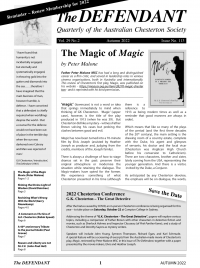I have just finished reading The Sins of G.K. Chesterton by Richard Ingrams and the review by Gary Furnell (The Defendant, Summer 2022), and I was driven to write something in defence of Chesterton.
Firstly, Ingrams is to be congratulated on the depth of his research. No stone was left unturned in his search for a sin committed by Chesterton.
However, the title to the book demands that some sort of sins be revealed. Yet it is only at end of the book (on page 242) that the supposed sins of Chesterton are disclosed. They are listed as follows:
- the unspecified experience of Gilbert at London’s Slade School of Fine Art
- the treatment by Gilbert of his friends Gardiner, Masterman and Cadbury
- the stories told by Gilbert about how his brother died
- the written attack by Gilbert on Rufus Isaacs
I will respond to the first claimed sin, the unspecified experience of Gilbert at the Slade School of Fine Art, and leave it to others to respond to the rest.
Ingrams only mentions Slade in a few lines in the whole book of over 6000 lines. The first is a passing reference (at page 39) to Gilbert attending the Slade School of Fine Art for a year, and then at pages 233/334:
“The process of his slow conversion began when he was an art student at the Slade and went through a period of acute depression during which he had ‘an overpowering impulse to record or draw horrible ideas and images.’ Evelyn Waugh has mentioned rumours of homosexuality at this period in his life, and Wilfrid Blunt refers in his diary to an attempt by Lord Alfred Douglas to blackmail him which he and Belloc managed to prevent. Whatever his experiences were, they left Chesterton with an abiding sense of evil- ‘I had dug
quite low enough to recognise the devil’- an experience previously promoted by playing with an Ouija board with Cecil. This frightened him so much that he vowed never to touch it again ‘with a bargepole.’”
This explosive allegation is not elaborated on. It is left there hanging in the air. It is in contrast to every other thing in the book, which is researched and revealed no matter how small. No evidence in any conversation or any other thing, nothing in all of Ingrams’ digging! Notwithstanding the tremendous detail throughout the book there is no reference to any correspondence or conversation which gives any detail of this alleged behaviour.
And at page 246, his conclusion:
“When it comes to confession, more than once Chesterton wrote that he became a Catholic to get rid of his sins, his followers deducing, probably correctly, that he harboured some deep seated feelings of guilt dating from his experiences at the Slade, which left him, as he said, with a strong sense of the physical nature of evil. Whatever may have been those sins, they must seem trivial compared to his treatment of his friends Gardiner, Masterman and Cadbury, his lies about Cecil’s death and his vicious and unprovoked attack on Rufus Isaacs.”
The Sins of G.K. Chesterton, p. 246
Even Ingram is extremely guarded in making this statement himself about Chesterton. Instead, he hides behind unnamed Chesterton’s followers in “deducing, probably correctly” regarding the allegation. He offers no evidence, and this reflects poorly on the credibility of Ingrams.
I have no doubt that Chesterton committed sins; he was human, but this does not license an allegation of a sin without evidence.
Robin Speed
Robin Speed has his own law practice in Sydney, Speed and Stracey, and co-founded the Rule of Law Institute whose purpose is to foster the rule of law in Australia by means of conferences, programs and public comment.
